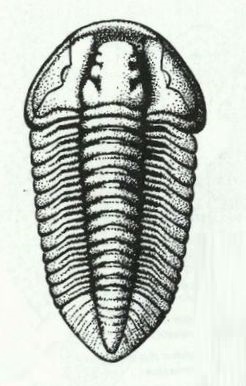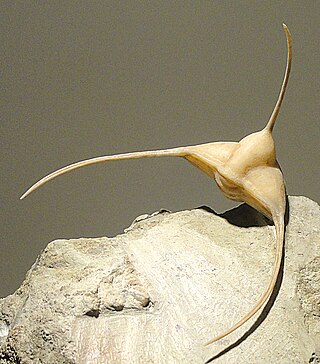
Agnostida are an order of extinct arthropods which have classically been seen as a group of highly modified trilobites, though some recent research has doubted this placement. Regardless, they appear to be close relatives as part of the Artiopoda. They are present in the Lower Cambrian fossil record along with trilobites from the Redlichiida, Corynexochida, and Ptychopariida orders, and were highly diverse throughout the Cambrian. Agnostidan diversity severely declined during the Cambrian-Ordovician transition, and the last agnostidans went extinct in the Late Ordovician.

The Burgess Shale is a fossil-bearing deposit exposed in the Canadian Rockies of British Columbia, Canada. It is famous for the exceptional preservation of the soft parts of its fossils. At 508 million years old, it is one of the earliest fossil beds containing soft-part imprints.

The Ordovician is a geologic period and system, the second of six periods of the Paleozoic Era, and the second of twelve periods of the Phanerozoic Eon. The Ordovician spans 41.6 million years from the end of the Cambrian Period 486.85 Ma to the start of the Silurian Period 443.1 Ma.
The PaleozoicEra is the first of three geological eras of the Phanerozoic Eon. Beginning 538.8 million years ago (Ma), it succeeds the Neoproterozoic and ends 251.9 Ma at the start of the Mesozoic Era. The Paleozoic is subdivided into six geologic periods, Cambrian, Ordovician, Silurian, Devonian, Carboniferous and Permian. Some geological timescales divide the Paleozoic informally into early and late sub-eras: the Early Paleozoic consisting of the Cambrian, Ordovician and Silurian; the Late Paleozoic consisting of the Devonian, Carboniferous and Permian.

The Silurian is a geologic period and system spanning 24.6 million years from the end of the Ordovician Period, at 443.1 million years ago (Mya), to the beginning of the Devonian Period, 419.62 Mya. The Silurian is the third and shortest period of the Paleozoic Era, and the third of twelve periods of the Phanerozoic Eon. As with other geologic periods, the rock beds that define the period's start and end are well identified, but the exact dates are uncertain by a few million years. The base of the Silurian is set at a series of major Ordovician–Silurian extinction events when up to 60% of marine genera were wiped out.

Trilobites are extinct marine arthropods that form the class Trilobita. Trilobites form one of the earliest known groups of arthropods. The first appearance of trilobites in the fossil record defines the base of the Atdabanian stage of the Early Cambrian period and they flourished throughout the lower Paleozoic before slipping into a long decline, when, during the Devonian, all trilobite orders except the Proetida died out. The last trilobites disappeared in the mass extinction at the end of the Permian about 251.9 million years ago. Trilobites were among the most successful of all early animals, existing in oceans for almost 270 million years, with over 22,000 species having been described.

An evolutionary radiation is an increase in taxonomic diversity that is caused by elevated rates of speciation, that may or may not be associated with an increase in morphological disparity. A significantly large and diverse radiation within a relatively short geologic time scale is often referred to as an explosion. Radiations may affect one clade or many, and be rapid or gradual; where they are rapid, and driven by a single lineage's adaptation to their environment, they are termed adaptive radiations.

The Cambrian–Ordovician extinction event, also known as the Cambrian-Ordovician boundary event, was an extinction event that occurred approximately 485 million years ago (mya) in the Paleozoic era of the early Phanerozoic eon. It was preceded by the less-documented End-Botomian mass extinction around 517 million years ago, and the Dresbachian extinction event about 502 million years ago.
Derek Ernest Gilmor Briggs is an Irish palaeontologist and taphonomist based at Yale University. Briggs is one of three palaeontologists, along with Harry Blackmore Whittington and Simon Conway Morris, who were key in the reinterpretation of the fossils of the Burgess Shale. He is the Yale University G. Evelyn Hutchinson Professor of Geology and Geophysics, Curator of Invertebrate Paleontology at Yale's Peabody Museum of Natural History, and former Director of the Peabody Museum.

Flexicalymene Shirley, 1936. is a genus of trilobites belonging to the order Phacopida, suborder Calymenina and Family Calymenidae. Flexicalymene specimens can be mistaken for Calymene, Gravicalymene, Diacalymene and a few other Calymenina genera. They are used as an index fossil in the Ordovician. Ohio and North America are particularly known for being rich with Flexicalymene fossils.

Ronald Pearson Tripp FRSE was a British palaeontologist specializing in trilobites. He was self-taught in palaeontology and became an authority on the taxonomy of the trilobite order Lichida and the trilobite family Encrinuridae.

Life: A Natural History of the First Four Billion Years of Life on Earth is a book about natural history by British paleontologist Richard A. Fortey. It was originally published in hardcover in Great Britain by HarperCollins Publishers, under the title Life: An Unauthorised Biography. Fortey used this book to explain how life has evolved over the last four billion years. He discusses evolution, biology, the origin of life, and paleontology. Under its various titles Fortey's book has become a best-seller; according to WorldCat, it is in over a thousand public libraries in the United States alone.

The history of invertebrate paleozoology differs from the history of paleontology in that the former usually emphasizes paleobiology and the paleoecology of extinct marine invertebrates, while the latter typically emphasizes the earth sciences and the sedimentary rock remains of terrestrial vertebrates.

Cloacaspis is an extinct genus of Olenid Ptychopariid trilobite. It lived during the early part of the Arenig stage of the Ordovician Period, a faunal stage which lasted from approximately 478 to 471 million years ago. Richard Fortey has proposed that these particular trilobites lived in anoxic regions of the ocean floor, and cultivated symbiotic, sulfur-metabolizing bacteria.

Norasaphus monroeae is a species of asaphid trilobites named after Marilyn Monroe for its hourglass-like shaped glabellum. Its fossils are found in Arenig-aged marine strata from the Nora Formation, in the Georgina Basin, situated between the Northern Territory and Queensland, Australia.

The Fezouata Formation or Fezouata Shale is a geological formation in Morocco which dates to the Early Ordovician. It was deposited in a marine environment, and is known for its exceptionally preserved fossils, filling an important preservational window beyond the earlier and more common Cambrian Burgess shale-type deposits. The fauna of this geological unit is often described as the Fezouata biota, and the particular strata within the formation which exhibit exceptional preservation are generally termed the Fezouata Lagerstätte.

Trinodus is a very small to small blind trilobite, a well known group of extinct marine arthropods, which lived during the Ordovician, in what are now the Yukon Territories, Virginia, Italy, Czech Republic, Poland, Denmark, Sweden, Svalbard, Ireland, Scotland, Wales, Iran, Kazakhstan and China. It is one of the last of the Agnostida order to survive.

Ogygiocarella Brongniart, 1822, is a genus of asaphid trilobites. It occurred during the Middle Ordovician.

Raphiophoridae is a family of small to average-sized trilobites that first occurred at the start of the Ordovician and became extinct at the end of the Middle Silurian.
Cyclopygoidea is a superfamily of trilobites in the order Asaphida, containing the families Cyclopygidae, Nileidae, Symphysurinidae, and Taihungshaniidae. Some subgroups such as the Cyclopygidae are thought to have lived in the water column in the deep sea, where as telephinids such as Carolinites inhabited epipelagic depths. Some members of the family Nileidae were moved outside of it. The first cyclopygoids were of the family Simphysurinidae such as Symphysurina in Furongian North America.

















